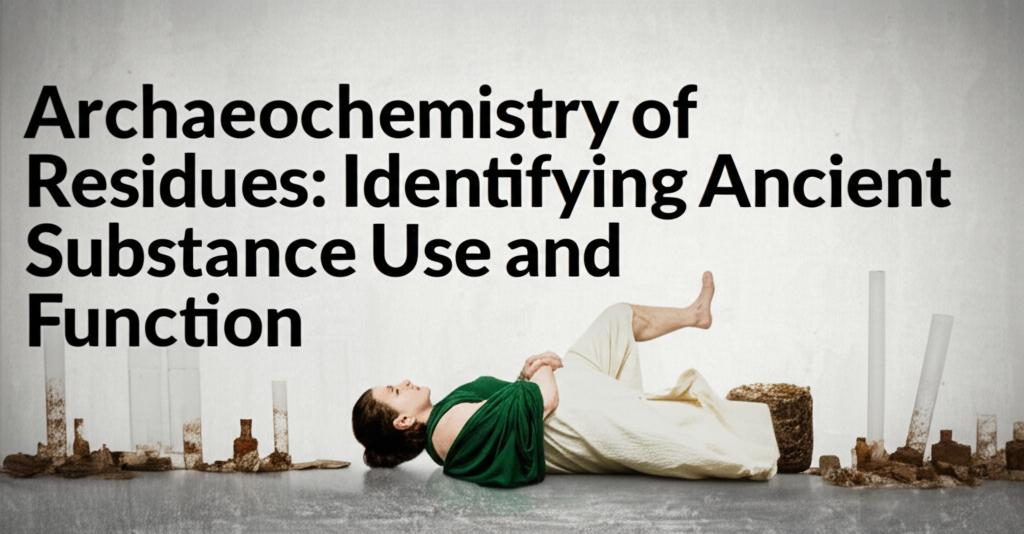Archaeochemistry delves into the past by applying chemical techniques to analyze ancient materials, and the study of residues offers a powerful window into how ancient peoples interacted with their world. Organic Residue Analysis (ORA) specifically focuses on the microscopic traces of organic substances like lipids, proteins, starches, and sugars that become trapped within or adhered to artifacts over time. These invisible remnants hold direct evidence of past activities, often revealing details that skeletal remains or artifact forms alone cannot.
Where Residues Are Found and What They AreResidues aren't just obvious stains; they are often absorbed into the very fabric of artifacts. Porous materials like unglazed pottery are particularly adept at trapping organic molecules from substances they once held, making them a primary target for analysis. However, residues can also be found adhering to stone tools, preserved within dental calculus (hardened plaque on teeth), in the mineral matrix of bones, within sediments from habitation floors or pits, and even in amorphous materials like ancient glues, pigments, cosmetics, or substances used in mummification. These residues originate from a vast range of activities including food preparation, cooking, storage, transport, tool use, medicine preparation, ritual practices, and crafting. The organic components can include fats, oils, waxes, resins, sugars, proteins, and various metabolites – small molecules involved in biological processes.
Unlocking the Past: Analytical TechniquesIdentifying these trace substances requires sophisticated analytical chemistry techniques. Gas Chromatography-Mass Spectrometry (GC-MS) is a cornerstone method, particularly for lipids. It separates complex mixtures and identifies individual molecules based on their mass and fragmentation patterns. High-Temperature GC-MS (HTGC-MS) allows for the analysis of larger lipids like triglycerides without prior breakdown. Liquid Chromatography-Mass Spectrometry (LC-MS) is another vital technique, often employed alongside GC-MS, particularly in the burgeoning field of metabolomics within archaeology.
Metabolomics focuses on identifying small molecules (metabolites, generally 50-1500 Daltons), which can provide highly specific "chemical fingerprints" of substances used, sometimes even distinguishing between closely related plant species. Proteomics, the study of proteins, can identify species origins from blood or tissue residues and shed light on food processing techniques.
Spectroscopic methods like Fourier-Transform Infrared (FTIR) spectroscopy, Raman spectroscopy, and Nuclear Magnetic Resonance (NMR) help identify the chemical structures of compounds, sometimes non-destructively. X-ray Fluorescence (XRF) is often used for elemental analysis of inorganic components or sediments, helping understand material composition or site activities like fire use. Isotope analysis examines the ratios of stable isotopes (like carbon or nitrogen) within molecules, providing clues about the geographic origin of materials, differentiating between types of animal fats (e.g., ruminant vs. non-ruminant, milk fat), or identifying specific dietary staples like maize.
Researchers increasingly use multi-platform approaches, often starting with non-destructive techniques before moving to methods that require sample extraction. Identifying specific "biomarkers" – molecules characteristic of a particular substance (like caffeine and theobromine for cacao, nicotine for tobacco, or tartaric acid for grapes/wine) – is a key goal.
Revealing Ancient Life: What Residues Tell UsThe applications of residue analysis are broad, offering insights into many facets of ancient life:
- Diet and Foodways: Analysis reveals ingredients stored or cooked in pottery (animal fats, plant oils, dairy products), identifies specific plants and animals consumed, and reconstructs ancient recipes and cuisines. Researchers can differentiate between ruminant and non-ruminant fats, detect marine resources, and identify staple crops.
- Beverages: Evidence of ancient alcoholic beverages like wine and beer has been detected through characteristic biomarkers and fermentation indicators. For example, traces of beeswax helped reconstruct a Mayan beer recipe.
- Medicine, Ritual, and Psychoactive Substances: Residues can identify medicinal herbs, tree resins, and psychoactive substances used in healing, rituals, or recreation. Examples include detecting nicotine from tobacco, opiates from poppies, psilocybin from mushrooms, capsaicin from chili peppers, or compounds from plants like Ephedra or wormwood in vessels or pipes. Substances used in embalming or burial rites also leave chemical traces.
- Crafts and Technology: Analysis identifies materials used in ancient technologies, such as plant- or animal-based adhesives, tars for waterproofing or hafting tools, pigments used in paints, and dyes for textiles. Understanding these materials sheds light on ancient crafting techniques and knowledge.
- Trade and Interaction: Identifying the source of materials through chemical (e.g., resin compounds) or isotopic signatures can help reconstruct ancient trade routes and economic networks. Analysis of residues in transport vessels like amphorae reveals the commodities being moved.
While powerful, residue analysis faces challenges. Degradation processes over long burial periods can alter or destroy organic molecules. Contamination from the burial environment or during excavation and handling is a constant concern. Differentiating between mixtures or identifying heavily processed materials can also be complex.
Recent advancements, particularly in metabolomics, offer greater precision, allowing for more confident identification and even differentiation between closely related species used in the past. Improved extraction techniques are yielding more material for analysis. Proteomics holds promise for detailed food identification. Continued development aims to enhance sensitivity, minimize destructive sampling, and build more comprehensive reference libraries of ancient substances and their degradation products. By combining these chemical insights with traditional archaeological methods, archaeochemistry of residues continues to provide increasingly detailed and direct evidence of how people lived, worked, ate, healed, and interacted with the substances that shaped their world.

